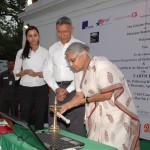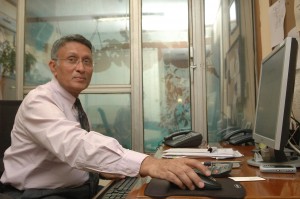The Building that Can Change the World and Solve the World’s Biggest Climate Change Problem
by Don Debelle
When doctors told Kamal Meattle that his lung capacity had dropped to 70%, and it was Delhi’s air that was killing him, he had two choices: leave friends, family and the life he had built for more than five decades, and move to New Zealand or Canada – or find a solution. An MIT and Sloan School of Management graduate, Kamal was on the Board of Governors of India’s premier technology institute – IIT New Delhi, and now it was payback time. “Where was the solution? Who had been thinking about and researching on air purity,” he asked. Together, Kamal and a team from IIT began the search for a solution. “One place we discovered was NASA,” he says. In their research for off planet colonies, NASA had been experimenting on using plants to “grow” fresh air, but their research was classified. Creating fresh air classified? you ask. So it seems, but Kamal recalls, “We knew that we had found an idea worth exploring.
The thought of using plants to ‘grow’ fresh air was a green and healthy solution – something that should have been so obvious and intuitive, but had been overlooked completely by all but a very few researchers.” They were onto something, and that it was leading edge research made it all the more fascinating to Kamal.
Kamal recalls that “What we eventually found, through our own (Paharpur Business Centre) research [how did they find this?] was three common and easily grown house plants that can grow all the fresh air that is needed indoors”:
· “The Living Room Plant” Areca Palm (Chrysalidocarpis lutescens) which converts CO2 to oxygen during the day.
· “The Bedroom Plant” Mother-in-law’s Tongue (Sansevieria trifasciata) which does the same at night.
· “The Specialist Plant” the Money Plant (Epipremnum aureum) that absorbs formaldehydes and volatile chemicals from the air.
[consider something about how Kamal implemented these ideas in his building as an intro the following paragraph]
He runs off figures from recent studies in the office building that he manages, Paharpur Business Centre (PBC), in the heart of New Delhi, “when compared to other Delhi buildings, these plants lower eye irritation by 52%, respiratory symptoms by 34%, headaches by 12%, lung impairment by 24% and asthma by 9%. They also found a 42% probability of increasing blood oxygen by 1%. All this has led to 20% higher productivity and has also reduced energy requirements by 15%, because less outdoor ‘fresh air’ needs to be cycled into the building.” The improved air quality is immediately noticeable; you feel like you are at a hill station the moment you enter the building.
Their research soon began to attract the interest of others, and hearing of him, Chris Anderson at TED invited Kamal to address the TED Conference and bring his ideas on how to grow fresh air to the world.
Kamal is a big thinker. He is not intimidated by the challenges that face him; rather, he seems to draw inspiration from them. There are many who talk about the environment and its problems, but Kamal is really doing something. He quotes and lives the motto of Mahatma Gandhi: “Be the change you want to see in the world.”
The Earth’s climate is a complex, non-linear system, and the exact details will always be debated, but the trend is real, observable, and quickly moving towards critical tipping points. We are presently approaching many interconnected tipping points, which once crossed will be irreversible and where each one will feed into the next. Perhaps the most important and critical of these are: Instead of this para we suggest – Climate Change is real and is happening over time and humans are contributing to it, perhaps the most important and critical evidences are as under:
· The melting of the polar ice cap. Large ice sheets act like gigantic mirrors, reflecting sunlight back into the cosmos. As sea-ice melts, it exposes a much darker ocean surface, which absorbs more radiation – amplifying the warming. It is expected that this will lead to far-reaching changes in ocean circulation and climate patterns across the whole Northern Hemisphere.
· The thawing of the permafrost in northern Canada and Russia which holds an estimated 500 gigatons of carbon that is being released into the atmosphere as methane, a greenhouse gas 20 times more potent than carbon dioxide.
· The oceans act as the planet’s main carbon sink and currently absorb over 40 % of the CO2 emitted by human activity. As the planet warms so to do the oceans, losing their ability to absorb CO2. Once they become saturated and no longer absorb CO2, planet will warm even more quickly. This will accelerate the warming of the oceans, which will then begin to give up the CO2 that they have sequestered for centuries.
Geo-engineering will not solve the problem; it will only buy us time and allow us to make the necessary changes. If those changes are not made, and these tipping points are crossed, what scientists fear is that runaway global warming could be unleashed and that the planet will no longer be able to support life as we know it. It is impossible to overstate the direst implications of what this will mean.
Kamal states, “I knew we had only a few decades to find solutions to these problems, and I began looking for ways to help. Inspired by what I had discovered in growing fresh air with plants, I began retrofitting PBC with green, healthy, energy efficient technologies. As a result, PBC is now targeting LEED EB O&M Platinum Certification by mid of 2010. PBC became a study in the best technologies available, and when a UNEP press release on the energy footprint of buildings caught my attention, my interest in green building technologies grew into the solution I had been looking for.” PBC posts its daily indoor air quality readings / data on its website
Buildings account for 50% of all Green House Gas emissions, and the building sector makes up roughly 40% of global energy use. According to the UNEP press release, “building sector world-wide could deliver emission reductions of 1.8 billion tonnes of C02. A more aggressive energy efficiency policy might deliver over two billion tonnes, or close to three times the amount scheduled to be reduced under the Kyoto Protocol.”
Kamal comments, “This presented a real opportunity to make a difference. I decided that if we could build the world’s greenest, most energy efficient building, and showcase the technologies used, it would serve as an example on which all future buildings could be modeled.” And so the concept for GreenSpaces began to take shape. “I again called on friends and colleagues from around the world to help,” says Kamal, and before long he had attracted the attention of international organizations, businesses and government laboratories ready to partner with him in his project. These included: the OECD; the Asia-Pacific Partnership on Clean Development and Climate (APP) an international non-treaty agreement among Australia, Canada, India, Japan, the China, South Korea, and the US; as well as a number of US government energy research laboratories, IBM, GE and others.
He maintains, “It is no exaggeration to say that this will be the world’s greenest and most energy efficient commercial / office building over a million square feet. When built, GreenSpaces will showcase the world’s best and most energy efficient technologies and demonstrate that the energy footprint of buildings can be economically reduced from 40% to 10%, with today’s proven technologies.” And, this will not be achieved at a cost to quality of life. Rather, using Kamal’s special plants to grow fresh air in the new building, as well as other innovations he has discovered, will put GreenSpaces in a class by itself. Not only will it be one of the healthiest buildings in the world, but the improved energy efficiencies brought about by the use of plants and other innovative energy efficient technologies will mean that GreenSpaces will be at least 15%(To check with Mr. Meattle if its 15% or more) more energy efficient than the newly constructed Bank of America Tower, New York, USA.
Kamal says, “One of our goals in GreenSpaces has been to prove that this can be done in a way that is financially viable. It is all but meaningless to build this building if costs are not controlled.” Even though the projected cost of GreenSpaces is 263 million US $, with an incremental cost of 58% compared to an “A” class commercial building. The energy efficiencies achieved will mean that additional costs will be paid back in six years.
Kamal says, “Even though we have chosen the best technologies known to us, there are certainly technologies which we haven’t discovered that could improve on energy efficiencies or reduce costs further.” But what are those technologies? Where are they? How would you find them? These questions seemed unanswerable, until a small Canadian internet startup called Blue-Green Spaces which had been studying the use of collaborative networks for the environmental community approached him. Kamal recognized that this might be the opportunity he was looking for to uncover those new and hitherto, unknown technologies.
Initially inspired by the collaborative spirit that had made Wikipedia a reality, Blue-Green Spaces was at the leading edge of what was being made possible by the Web 2.0 internet. As recently as two years ago, Wikipedia had only 3 fulltime employees, and even now it numbers only around 20. Wikipedia, the encyclopedia, owes its existence to the real genius of its founder, Jimmy Wales, in creating a loyal, dedicated online core community of around 16,000 core users. It is a global collaborative volunteer effort that administers, monitors and cares for the Wikipedia project with love and dedication.
The question they had asked themselves at Blue-Green Spaces was this: why is it, if people are this dedicated to an encycleopedia, that something like this has not happened in the environmental community? Everywhere you go, you encounter a rising frustration in people who want to help, who want to really do something, to make a difference that matters, but who find no opportunity to truly make a difference on a scale that they feel would be meaningful. The answer to this problem was at the core of what Blue-Green Spaces had been studying.
Kamal’s entrepreneurial spirit saw an opportunity and together they launched the GreenSpaces Challenge. The idea was to invite people from across the Globe to contribute innovative, energy efficient and cost effective ideas, products and services. This is a platform for people to join in and make a difference to the way buildings will be built in future.
 Mrs. Sheila Dikshit, Chief Minister of Delhi, inaugurated an Awareness program on Climate Change for Delhi’s School Students and a web platform – GreenSpaces Ideas on Earth Day, Thursday, 22 April’2010 at 26, Prithiviraj Road, New Delhi-110011.
Mrs. Sheila Dikshit, Chief Minister of Delhi, inaugurated an Awareness program on Climate Change for Delhi’s School Students and a web platform – GreenSpaces Ideas on Earth Day, Thursday, 22 April’2010 at 26, Prithiviraj Road, New Delhi-110011.
 The need of the hour is to look at clean and environment friendly construction technologies and this must set the tone of the agenda for the new government. The government must ensure that all new construction, at least all government buildings in the country, is green, and effectively demonstrates the benefits to the private sector.
The need of the hour is to look at clean and environment friendly construction technologies and this must set the tone of the agenda for the new government. The government must ensure that all new construction, at least all government buildings in the country, is green, and effectively demonstrates the benefits to the private sector.